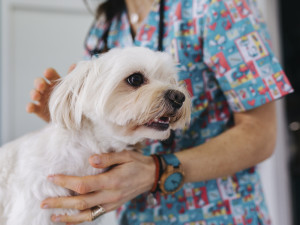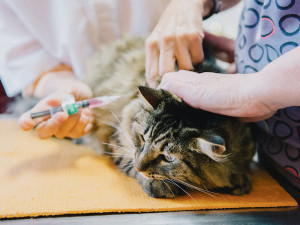Can My Dog or Cat Get RSV?
Luckily, RSV isn’t transmittable between humans and pets. But there are some particularly nasty viral respiratory infections to look out for.
If you live or work with children, you probably already know to be on the defense against respiratory syncytial virus (RSV). RSV is a contagious virus that causes mild, cold-like symptoms (sneezing, runny nose, sore throat, the works) in adults — but in infants, RSV can be extremely dangerous. That’s because young children have narrower airways, so inflammation caused by RSV can result in serious complications. Most people who spend time with kids already know about RSV’s heightened risk for human little ones, but the question remains: What about animals? Are our pets safe?
It’s not a silly question; some diseases (called “zoonotic” diseases) can be spread between animals and people — leptospirosis, for one.opens in new tab The good news: RSV isn’t one of these. A different version of RSV naturally occurs in calvesopens in new tab, but human RSV only shows up in humans and chimpanzees. So, don’t sweat — you can’t give RSV to your pup, or vice versa.
That said, dogs and cats are at risk of some ailments that present similarly to RSV. If your pet has been showing RSV symptoms, there may be another respiratory infection at bay. Here’s everything you need to know about preventing, spotting, and treating kennel cough in dogs and feline upper respiratory infection in cats.
What is kennel cough?
Kennel cough is a broad term covering any infectious or contagious condition in dogs, where coughing is one of the major clinical signs. It is also referred to as infectious tracheobronchitis. The term tracheobronchitis describes the location of the infection in the trachea or “windpipe” and bronchial tubes.
How much do you spend on your pet per year?
Because the infection spreads when dogs are housed together, it is often seen soon after dogs have been in kennels, hence the name kennel cough. Because kennel cough can be caused by a number of pathogens, it is often referred to as the canine infectious respiratory disease complex (CIRDC).
What are the clinical signs of kennel cough (other than coughing)?
Clinical signs may be variable. It is often a mild disease, but the cough may be chronic and last for several weeks in some cases. Common clinical signs include a loud cough often describe as a “goose honk,” runny eyes and nose, swollen tonsils, wheezing, lack of appetite, and depressed behavior.
Most dogs with infectious tracheobronchitis will cough when their throat is rubbed or during and after exercise. Often, the hacking cough caused by kennel cough will persist for several weeks after the infection. If your dog has kennel cough, it’s unlikely that they will lose their appetite or become lethargic.
How does a dog get kennel cough?
Kennel cough is very contagious, and dogs can readily transmit it by casual contact, such as sniffing each other when on a walk, playing, or sharing water dishes. Certain factors increase the likelihood that your dog may contract kennel cough including stress, cold temperatures, exposure to dust or smoke, and crowded conditions.
What is the treatment for kennel cough?
There is no specific treatment for these viral infections, but many of the more severe signs are due to bacterial involvement, particularly Bordetella bronchiseptica. Antibiotics are useful to fight it.
Some cases require prolonged treatment, but most infections resolve within one to three weeks. Mild clinical signs may linger for several weeks even when the bacteria have been eliminated. Cough suppressants and anti-inflammatory medications may provide relief in some cases. Your veterinarian will help you determine what methods of treatment are best for your dog.
How can I prevent my dog contracting kennel cough?
Most vaccination programs your veterinarian will recommend include adenovirus and parainfluenza. Bordetella vaccination is also highly recommended for dogs who are boarded, groomed, or interact with other dogs in crowded areas, such as dog parks.
What is feline upper respiratory infection?
Feline upper respiratory infection (URI) is the common term for a respiratory infection caused by one or more viral or bacterial agents. Synonyms for this condition include feline infectious respiratory disease and feline upper respiratory disease complex (URD). The infection may be caused by one or more viral and bacterial agents capable of causing disease in cats.
The most common viruses that cause upper respiratory infections in cats are feline herpesvirus type-1 (also known as feline viral rhinotracheitis or FVR) and feline calicivirus (FCV), while the most common bacteria that cause upper respiratory infections in cats are Bordetella bronchiseptica (B. bronchiseptica) and Chlamydophila felis (C. felis).
What are the symptoms of a feline upper respiratory infection?
The typical upper respiratory infection involves the nose and throat, causing symptoms, such as sneezing, nasal congestion, conjunctivitis (inflammation of the membranes lining the eyelids), and discharge from the nose or eyes. Discharge may be clear or may become purulent (cloudy in appearance and containing pus).
With FVR and FCV, the cat may develop ulcers in the mouth. Less specific symptoms of an upper respiratory infection include not eating, lethargy, fever, enlarged lymph nodes, and blepharospasm (squinting). In severe cases, the cat may have difficulty breathing.
How does a cat get an upper respiratory infection?
The viruses and bacteria that cause URIs in cats are highly contagious. An infected cat will shed contagious particles in saliva or secretions from their nose or eyes. Susceptible cats can get an infection by direct contact with another infected cat or by environmental exposure to objects that have been contaminated with infectious secretions, such as food and water bowls, toys, litter boxes, and bedding. Most cases are associated with direct contact because the viruses and bacteria only survive for a short period of time in the environment and are readily destroyed by proper disinfection.
Several of these diseases can cause a carrier state in cats that have apparently recovered from an infection, and female carriers can pass the infection on to their newborn kittens.
How long does a typical feline upper respiratory infection last?
Once a cat is exposed to an infectious agent, the virus will go through an incubation period of two to 10 days before the cat starts showing clinical signs. If the infection is uncomplicated, it will typically last for seven to 10 days, although signs may persist for up to 21 days in some cases. During this entire time, the cat may be infective to other cats.
With FVR, all cats become chronic carriers, meaning that they will have the disease for life. In some cats that carry FVR, stress (because of surgery, other illnesses, changes in the home, boarding, etc.) may cause the virus to become reactivated throughout life. With FCV, about half of infected cats will become carriers of the disease. In some cases, the carrier state may only last for a few months. In a small percentage of cats, the carrier state may persist for life. These persistent carriers are usually asymptomatic but still serve as a constant source of FCV to susceptible cats.
How is a feline upper respiratory infection treated?
Most cats with an uncomplicated upper respiratory infection can be treated symptomatically at home. Your veterinarian may prescribe an eye medication if your cat has a purulent eye discharge. Although viral infections do not respond to antibacterial drugs, broad-spectrum antibacterial drugs may be prescribed to prevent secondary bacterial infections from complicating the disease, particularly in kittens. Primary bacterial upper respiratory infections caused by Bordetella or Chlamydophila will be treated with specific antibiotics that are effective against these diseases.
Cats with nasal or airway congestion may benefit from increased environmental humidification, such as spending 10 to 15 minutes in a steamy bathroom several times per day. Some cats will benefit from nose drops if the nasal discharge is particularly severe or the nasal tissues become painful. To minimize irritation from nasal discharge, it is often helpful to wipe the cat's face or eyes with a moist tissue. Because cats with a respiratory infection will have a decreased sense of smell, they often have a decreased appetite. Feeding them a canned food they like may help improve their appetite. In some cases, your vet might prescribe an appetite stimulant.
If your cat is dehydrated, depressed, or has a severe case of illness, your veterinarian will recommend hospitalization for more intensive treatment, including fluid replacement therapy and other supportive treatments.
How can feline upper respiratory infections be prevented?
Upper respiratory infections can be caused by a variety of different disease agents, so it is not always possible to prevent them. But there are standard “core vaccines” that provide protection against FVR and FCV. There is also a vaccine that protects against feline chlamydiosis (eye infection caused by the bacteria c. felis). Your vet will only recommend this vaccine if your cat has a reasonable risk of exposure to feline chlamydiosis. There is also a vaccine for a rare — but especially serious — form of calicivirus, known as hemorrhagic calicivirus.
None of these vaccines will completely prevent an infection from occurring if your cat is exposed to the disease, but they will significantly reduce the severity of the infection and shorten the length of the illness.
Boarding facilities, humane societies, animal shelters, and cat shows are all places where susceptible cats can be readily exposed to these infectious diseases. Preventing direct contact between your cat and other cats will greatly minimize the chance that your cat will pick up an infection. Following good sanitation and hygiene practices, such as washing your hands thoroughly before and after petting another cat, will further reduce the likelihood of disease spread between cats.
Is my family at risk?
Most of the infectious diseases that cause upper respiratory infections in dogs and cats are very species-specific and do not represent any risk to people. Bordetella bronchiseptica can, in certain circumstances, cause illness in peopleopens in new tab with an immune system disease. There are isolated reports of people who live in the same household as an affected cat developing C. felis-associated conjunctivitis.
Follow good hygiene practices to lessen the chance of infection, and if anyone in your household develops sore or runny eyes or signs of a respiratory infection while your cat is ill, consult your doctor as soon as you can. Fortunately, these zoonotic infections are extremely rare.










